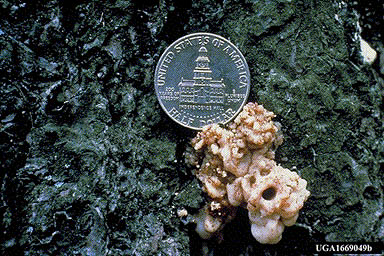Black Turpentine Beetle
Dendroctonus terebrans
Natural History

Pitch tube created by the black turpentine beetle
Photo credit: North Carolina State University Archives
The black turpentine beetle (Dendroctonus terebrans) causes problems in pine trees from New Hampshire to Florida, and from West Virginia to east Texas. The common name of this insect describes its color and indicates that it frequently attacks pine trees being worked for turpentine. (For more information about the way pine pitch has historically been collected for making turpentine, see the catface page.)
Healthy trees can often fend off black turpentine beetle attacks by producing large amounts of pitch, drowning the beetles in sap. Stressed trees cannot produce large enough amounts of pitch to be effective against the beetles.
This beetle chews its way through the dead, outer bark to get to the living inner bark (phloem), where it lays eggs. As the eggs hatch, the developing larva feed on the nutrient-rich inner bark until they mature, change into the adult stage, chew their way out through the dead bark, and emerge to disperse to other trees.
